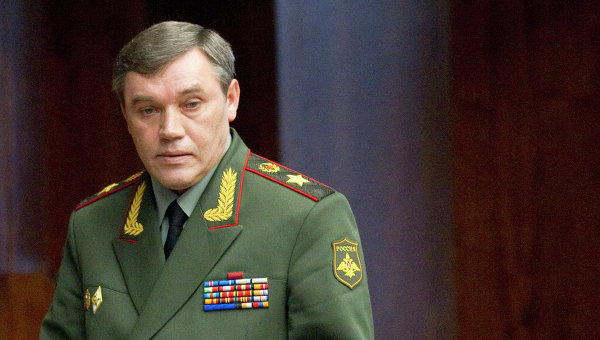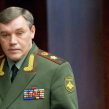
Russia’s Defense Leadership Reflects on 2014
Publication: Eurasia Daily Monitor Volume: 12 Issue: 7
By:

In December 2014, Russia’s defense leadership publicly reflected on what was deemed to be a highly successful year for the Armed Forces. Although similar statements frequently mark such year-end reflections, the consistency and confidence expressed in these comments from President Vladimir Putin and the senior leadership of the military, indicate real achievements were made. Moreover, by highlighting these issues, the top brass confirm the priority areas for Russian military development. Equally, many of these reflections were colored by changes to the threat environment in the context of the crisis in Ukraine (Krasnaya Zvezda, December 19, 2014).
Comments by Putin, Defense Minister Sergei Shoigu and the Chief of the General Staff (CGS), Army-General Valery Gerasimov, noted continued progress in military modernization and force development. Complex processes, including the creation of a new Joint Strategic Command in the Arctic as well as announcing plans to create Aerospace Forces (Vozdushno Kosmicheskiye Sily—VKS) in 2015, suggest the military is experiencing near constant change. On December 1, 2014, the new Arctic Command began to function. On December 18, Shoigu told the defense ministry collegium that the VKS will merge the Air Forces (Voyenno-Vozdushnye Sily—VVS) and the Aerospace Defense Forces (Voyska Vozdushno-Kosmicheskoy Oborony—VKO) into an entirely new structure (Krasnaya Zvezda, TASS, December 18, 2014). This organizational reform is likely in response to concern surrounding the United States’ Prompt Global Strike capability. It signals increased Russian attention to unifying and standardizing command-and-control and information-and-strike systems to protect the Russian State from potential air and space threats.
By far the most detail offered on force developments in 2014 appeared on the Russian defense ministry’s website following the ministry’s collegium meeting in December. This information includes details on platform and weapons systems procured during 2014, as well as future plans and opinions on the potential success of the State Armaments Program (GPV) to 2020. Among the most credible achievements of 2014 was the introduction of advanced automated command-and-control systems in the elite Airborne Forces, the Ratnik individual combat gear, along with advances toward enhancing contract service personnel numbers serving in the Russian Armed Forces (Mil.ru, December 19, 2014). These accounts also agree on the high priority Moscow attaches to modernizing its nuclear deterrent, upgrading and re-equipping the conventional forces, increasing training standards and raising the social conditions and prestige of military service (Krasnaya Zvezda, Mil.ru, December 19, 2014).
In this context, CGS Gerasimov offered the General Staff perspective on Russian military development in 2014. However, Gerasimov placed this in the context of the threat environment, heavily influenced by events in Ukraine and how Russia’s leadership sees the Western response to Moscow’s actions (Voyenno Promyshlennyy Kuryer, December 17, 2014). Gerasimov stated that the US and the North Atlantic Treaty Organization (NATO) consider Russia to be their geopolitical rivals, and are locked into “zero-sum” thinking. He said this is reflected in Western approaches to the crisis in Syria, Iran’s nuclear program, events in Ukraine and in missile defense. Gerasimov portrays Russia as being a victim of a hostile Western information campaign. On Ukraine, he claimed that this Western campaign has confused fact and forgery, resulting in ignorance of Russia’s real motives during the crisis (Voyenno Promyshlennyy Kuryer, December 17, 2014). He reiterated Russian concerns about deteriorating security in the Middle East and the possible impact of the International Security Assistance Force (ISAF) drawdown from Afghanistan on Central Asia.
Turning to achievements for the Russian military in 2014, Gerasimov ascribed prominence to the creation of the Arctic Command on the basis of the Northern Fleet and in “accordance with the approved Development Strategy of the President of Russia’s Arctic zone of the Russian Federation and national security for the period up to 2020.” In terms of procurement, he noted that, in 2014, nuclear modernization was marked by introducing “38 intercontinental ballistic missiles,” while the military received “more than 250 aircraft, about 280 armored combat vehicles, [and] more than 5,000 samples of automotive technology.” Unmanned Aerial Vehicles (UAV), modern anti-aircraft systems and the tactical missile system “Iskander-M” were also mentioned as signs of modernization and overall progress. Moreover, Gerasimov asserted that, in 2015, the military will receive “from 70 to 100 aircraft, 120 helicopters and 30 surface ships, submarines, special ships and support vessels, [as well as] up to 600 units of armored vehicles” (Voyenno Promyshlennyy Kuryer, December 17, 2014).
Gerasimov declared that the military is currently “90 percent” manned and that by the end of this year manning will rise to “95–100 percent.” Contract service is improving, according to the CGS, by enhancing recruitment and training for the contract soldiers (kontraktniki). Overall numbers of contract personnel serving in the Armed Forces has now reached 295,000, while some media sources claim they have reached the half-way mark in terms of the total personnel serving in the military (Voyenno Promyshlennyy Kuryer, December 17, 2014). Yet, by far the most significant achievement of the year, lies in the success of raising the societal prestige for the military; one independent sociological survey, cited by Gerasimov, suggests that 86 percent of Russians believe the military can protect the country from threats (Voyenno Promyshlennyy Kuryer, December 17, 2014).
Gerasimov encapsulated the view among the country’s defense leadership that 2014 was indeed a great year for the Russian military. Part of that also lies in the realm of the Ukraine crisis and how this was sold to the population and represented in the media. In late December 2014, the Ministry of Foreign Affairs summarized the main foreign policy events in 2014 and, unsurprisingly, offered an interpretation of the Ukraine crisis shared by the security elite: Namely, the “US and EU” had supported an “anti-constitutional coup” in Kyiv, which resulted in Moscow’s actions (Mid.ru, December 27, 2014).
If Moscow’s single greatest success in 2014 was to raise the prestige of the military, consistent efforts will need to be made to capitalize on this in the coming year. The highest overall priority remains the modernization of the strategic nuclear deterrent. However, by forming the new VKS on such a grand scale, which is consistent with the 2014 Military Doctrine’s reference to “non-nuclear deterrence” (see EDM, January 6, 2015), the challenge ahead will be immense. Managing these defense processes will be fraught with difficulties, especially given the ongoing risk that Russia may need to commit greater numbers and assets to Ukraine, or respond to a possible security crisis in Central Asia. And all these factors are made still more complex due to the downturn in Russia’s economy (Voyenno Promyshlennyy Kuryer, December 17, 2014).




